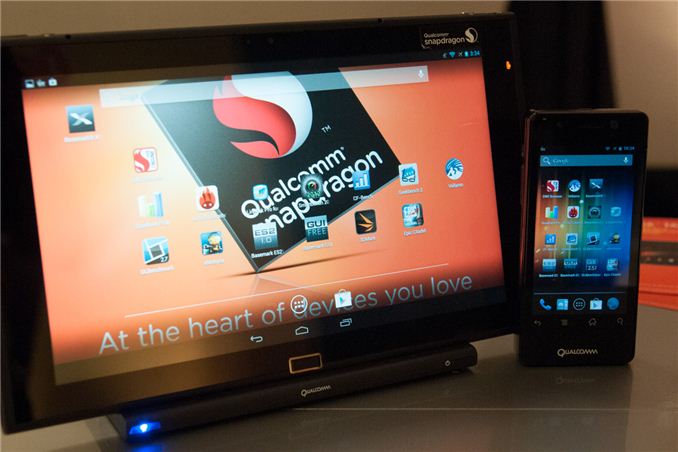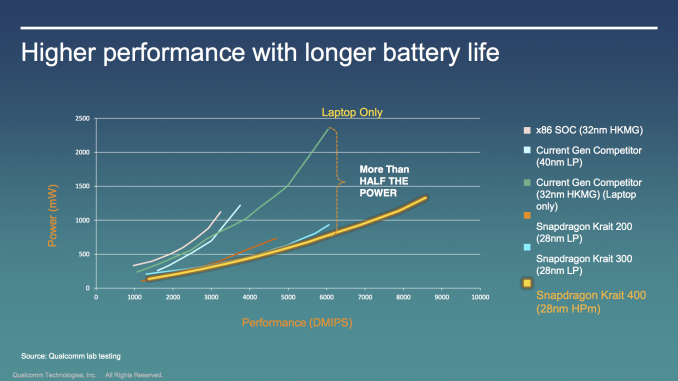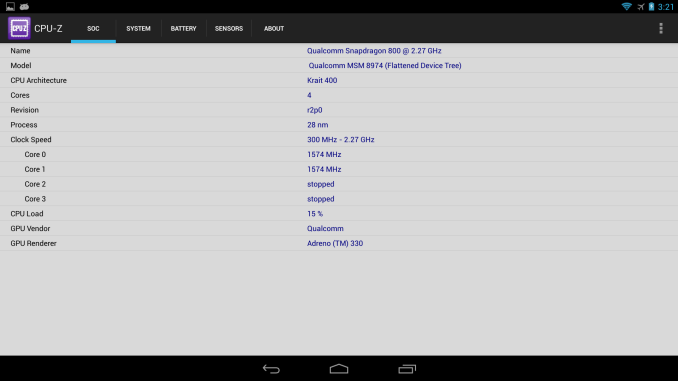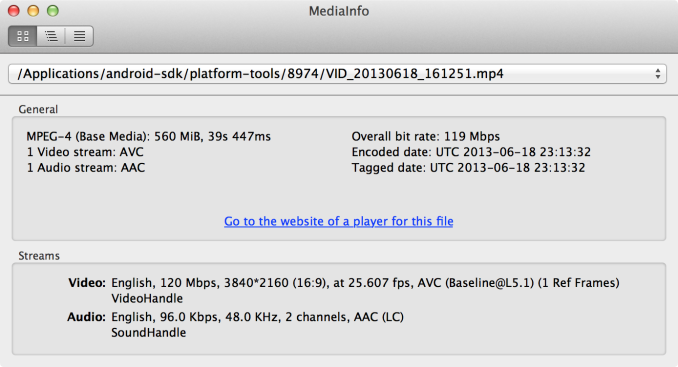Snapdragon 800 (MSM8974) Performance Preview: Qualcomm Mobile Development Tablet Tested
by Brian Klug on June 18, 2013 8:00 PM EST
We’ve written about Snapdragon 800 (MSM8974) before, for those unfamiliar, this is Qualcomm’s new flagship SoC with four Krait 400 CPUs at up to 2.3 GHz, Adreno 330 graphics, and the latest modem IP block with Category 4 LTE. Qualcomm is finally ready to show off MSM8974 performance on final silicon and board support software, and invited us and a few other publications out to San Francisco for a day of benchmarking and poking around. We looked at MSM8974 on both the familiar MSM8974 MDP/T, a development tablet used both by Qualcomm and 3rd parties to develop drivers and platform support, and the MSM8974 MDP phone, both of which have been publicly announced for some time now.
The tablet MDP is what you’d expect, an engineering platform designed for Qualcomm and other third parties to use while developing software support for features. Subjectively it’s thinner and more svelte than the APQ8064 MDP/T we saw last year, but as always OEMs will have the final control over industrial design and what features they choose to expose. Display is 1080p on the tablet and 720p on the phone, a bit low considering the resolutions handset and tablet markers are going for (at least 1080p on phone and WQXGA on tablets) so keep that in mind when looking at on-screen results from benchmarks.
| Qualcomm Snapdragon 800 Mobile Development Platform Tablet | |
| MSM8974 MDP/T | |
| SoC | MSM8974 Snapdragon 800 |
| CPU | 4x Krait 400 at 2.3 GHz |
| GPU | Adreno 330 at 450 MHz |
| RAM | 2GB 2x32 LPDDR3 800 MHz |
| NAND | 32 GB eMMC 4.5 |
| Cameras | 12 MP with flash (rear), 2 MP (front) |
| Display | 11.6-inch 1080p |
| I/O | USB 3.0, microHDMI, microSD, 3.5mm headset |
| OS | Android 4.2 |
Snapdragon 800, nee MSM8974 is built on TSMC’s 28nm HPM (High Performance for Mobile) HK-MG, as opposed to 28nm LP polysilicon (low power). The result are higher clocks for CPU, from 1.5–1.7 GHz on Krait 200–300 which was 28nm LP, to 2.2–2.3 GHz on Krait 400 on 28nm HPM. The jump between Krait 200 and Krait 300 brought higher clocks and also a jump in IPC, this time around Krait 400 is essentially a Krait 300 implemented on 28nm HPM, which means some relayout. There’s also a faster L2 cache on Krait 400.
These are final clocks on MSM8974 – Krait 400 runs its four cores at up to 2.3 GHz, though some lots will come at 2.2 GHz. GPU on MSM8974 is Adreno 330 which runs at 450 MHz and brings some architectural improvements over Adreno 320.
On the video side, MSM8974 is capable of encoding UHD 4K (3840 x 2160) 30 FPS video at up to 120 Mbps H.264 High Profile, and is capable of playing back the same file. Qualcomm had a demo going showing this mirrored on the latest Sony 4K UHD TV as well over microHDMI. I recorded a video sample and took a copy for your perusal and onto YouTube. True to their word the video I grabbed is 120 Mbps and 3840 x 2160, framerate was just over 25 FPS but I'm not sure if the demo was setup for 30 FPS capture. MSM8974 has the hardware encoder for H.264 but not HEVC H.265, that's implemented in software.
Snapdragon 800 should begin popping up in phones and tablets fall 2013. Anyhow let's take a look at MSM8974 performance.

























115 Comments
View All Comments
akbisw - Tuesday, June 18, 2013 - link
YESSS!!! THANK YOU QUALCOMM exactly What I expected!!!Piano Man - Tuesday, June 18, 2013 - link
Nice performance, but the lack of power utilization benchmarks prevents me from breaking out the party favors for the time being.clemsyn - Tuesday, June 18, 2013 - link
I agree, power utilization and heat are very important in mobile. Hope this don't come with a fan :)Xilliox - Wednesday, June 19, 2013 - link
I have been working on this for a long time, trust me, it does not need a fan!FwFred - Tuesday, June 18, 2013 - link
Comparing phones to a tablet is a bit odd. Glad there was a Nexus 10 at least.kcsween - Wednesday, June 19, 2013 - link
You all almost sound like this is Qualcomm's first go at making a mobile processor. I'd find it very hard to believe that they'd not take into consideration power consumption and heat or any other negative factors they considered when they made their other chips. Having said that, all that could be out the door in the race bigger and better, who knows. Guess we all will have to wait and see how this things performs in an actual smartphone.arkhamasylum87 - Tuesday, June 18, 2013 - link
How does this compare to the Ivybridge or Haswell Y series processors in terms of CPU/GPU performance? Would like to see those comparisons. So we can extrapolate how this will compare to a fanless Core product from Intel. The gap is there in terms of connectivity but the perf gaps on CPU/GPU would be interesting to note.teiglin - Tuesday, June 18, 2013 - link
Ivy Y no longer seems interesting to me but for the moment, Haswell 15W (both HD4600/5000) would be super interesting to add to the "great equalizer" page of charts. Doesn't Anand have an Acer with i7-4500U as well as the MBA with i5-4250U? Demand he run some benchmarks for you so you can update those charts. The comparison to i5-3317U made sense against APQ8064T, but 8974's contemporary is Haswell, not Ivy.And when you have Haswell Y samples, those would be neat, too. :)
jeffkro - Wednesday, June 19, 2013 - link
15W still requires a fan.sna1970 - Tuesday, July 9, 2013 - link
not really,the Haswell can run from 6 watts up to 15 watts.